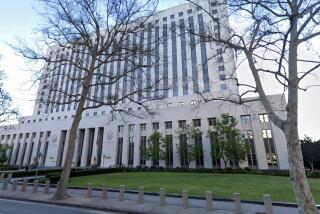Growers Count Losses, Find They Got Off Easy : Freeze: Local agriculture escaped cold snap with moderate frost damage, but the toll is much worse elsewhere in the state. Consumers will pay later.
As a slow warming trend took hold in Orange County and across California, agricultural inspectors spent Monday in citrus groves, vegetable fields and packinghouses trying to define the dimensions of the devastation that struck the state’s frostbitten agricultural industry.
Orange County’s $250 million in crops escaped the three days and nights of sub-freezing temperatures with only moderate frost damage, authorities said.
“Our preliminary data shows that there was spotty, moderate damage to the crops, but we don’t expect there to be record damage,” said Frank Parsons, deputy county agriculture commissioner.
But elsewhere around the state, the news was worse for growers and, ultimately, consumers.
In Tulare County alone, where most of California’s navel oranges are grown, Agricultural Commissioner Lenord Craft was estimating a $200-million loss in this year’s harvest, which could translate into a $700-million loss for the local economy. In Ventura County, destruction of nursery stocks, lemons and avocados totaled at least $100 million, Deputy Agricultural Commissioner Jim Fullmer said.
Even in urban Los Angeles County, agriculture officials said the chill caused at least $500,000 in damage, mostly to landscape bushes and flowers. “It could reach $1 million or $2 million easily,” said Bob Donley, deputy director in the agricultural commissioner’s office.
The arctic air mass that brought the freeze is slowly dissipating, forecasters said, granting a brief respite for the Christmas week, with temperatures in Orange County expected to reach the upper 50s to mid-60s.
But forecasters say that another cold front may be on the way. It is now riding along the Canadian Rockies and into Alaska.
“It’s fairly stationary, but it’s getting ready to make a move,” said meteorologist Steve Burbach of WeatherData Inc., which provides forecasts for The Times. Burbach predicted that the next frigid blast will hit Northern California over the weekend, arriving in the south early next week.
Burbach added, however, “It won’t be as widespread or as difficult to combat.”
Meanwhile, California continued Monday to feel the effects of the “Arctic Express,” as one National Weather Service forecaster dubbed the front that swept in four days ago.
Overnight lows in Orange County were expected to dip into the low 30s.
In Los Angeles, a low of 35 degrees Monday came within two degrees of the record low for the date, set in 1879.
Records did fall, however, in San Francisco with a low of 32, in Oakland with a low of 34 and in San Jose, where the mercury bottomed out at 23.
In Los Angeles County, the coroner’s office reported two possible hypothermia deaths. The body of a 47-year-old man was found Saturday in his mobile home in the northeast San Fernando Valley and an elderly woman was discovered Sunday in her garage in the Wilshire area. Orange County authorities also reported Sunday that a 57-year-old transient died of hypothermia in Anaheim.
In the Antelope Valley, Thomas Hunsaker, 21, was killed after he lost control of his car, which hit an ice patch and skidded into a light pole at 17th Street and Avenue K in Lancaster, sheriff’s deputies said. Temperatures there had dropped to 5 degrees.
Scores of homeless people looking to escape subfreezing temperatures were expected to seek warmth at Orange County’s two National Guard armories in Santa Ana and Fullerton, each housing up to 250 people.
The Southern California Gas Co. reported that natural gas consumption was running about double the normal daily average for the year. Friday’s total of 5.3 billion cubic feet set an all-time high in Los Angeles, spokeswoman Mabel Solares said.
Farther north, in the Santa Cruz Mountains, authorities were alarmed by a severe water shortage apparently caused by people running their faucets to prevent frozen pipes.
Burst pipes were a common complaint from Napa Valley wineries to the Los Angeles Equestrian Center in Burbank. Sheriff’s officials in the Antelope Valley reported receiving 200 to 300 calls a day asking for help with their plumbing.
The food industry took stock Monday, attempting to measure the effect of agriculture’s losses on supermarket prices and supply.
Until the weekend, the state had been projecting a crop of 80 million 37 1/2-pound cartons of navel oranges for the season, which runs from October through April, 1991. And 46 million cartons of Valencia oranges were expected from March through December or January, said Ron Radenz, a statistician for the California Agricultural Statistics Service.
Sunkist Growers Inc. cooperative spokeswoman Claire Peters said preliminary estimates indicate that 50% of the citrus crop may have been damaged. Some of the damaged crop, however, may be salvaged for juice, she said.
“There will be fewer fruit and what there is will cost more,” Peters said.
About 20% of the avocado crop was lost to the cold front, said Mark Affleck, president of the California Avocado Commission. The state produces 90% of the nation’s avocados.
Still, he said, the 1991 harvest may be higher than the 200 million pounds picked in 1990.
Buyers for the 104-store Stater Bros. chain said they don’t know whether they will have enough winter fruit and produce to meet demand.
“We’re evaluating ads that we are running in the next two weeks to be sure we will have what’s advertised,” said Stater Bros. Chairman Jack H. Brown. “If not, we will have to pull them and substitute other items.”
Importers of Chilean fruit expect demand to pick up for their product as grocers seek to make up for lost California supplies.
Flowers may also be affected. If there is much more cold weather, Valentine’s Day bouquets “may cost you a little extra,” said Marilyn Corodemas, chief deputy agriculture commissioner for San Diego County, where the most flowers in the state are grown.
In Orange County, Agriculture Commissioner Parsons said: “It will take three or four days to get a really good estimate on the damage, to see which plants are going to be lost, but right now we can tell there is obviously going to be some dollar loss.”
Among major crops sustaining damage, he said, were citrus, avocado, strawberry and ornamentals.
Alan Reynolds, orchard manager for Treasure Farms in Irvine, said he had six helicopter and wind machines working over the weekend in an attempt to mix the warmer air above the ground with the frigid ground-level air.
He said he lost about 10% of his Valencia orange crop. “We feel real fortunate compared to other (growers) in the state,” said Reynolds, who added that damage in the Central Valley may make it a more profitable year for his crops.
“Even with the loss it could be a pretty decent year for us,” he said.
Contributing to this story were staff writers David Ferrell, Penelope McMillan and Jesus Sanchez in Los Angeles; Tom Furlong, Matt Lait and Eric Lichtblau in Orange County; John Rivera in the Antelope Valley; Pysche Pascual in Ventura County; Linda Roach Monroe in San Diego and Jonathan Weber in San Francisco, and correspondent Mark Arax in Fresno.
More to Read
Sign up for Essential California
The most important California stories and recommendations in your inbox every morning.
You may occasionally receive promotional content from the Los Angeles Times.






